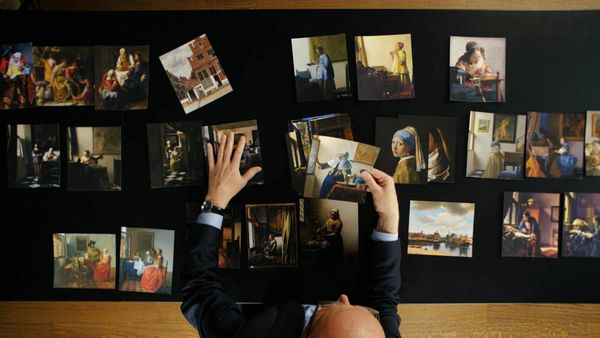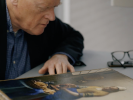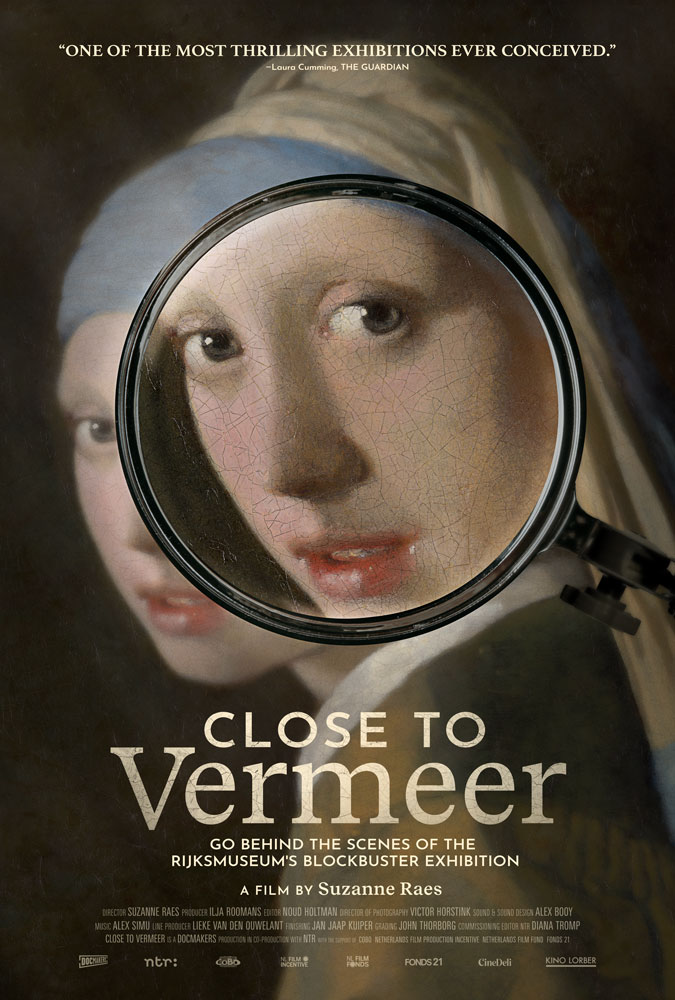Eye For Film >> Movies >> Close To Vermeer (2023) Film Review
Close To Vermeer
Reviewed by: Jennie Kermode

You wait years for a documentary about the Dutch Baroque Period’s most famous painter and then two come along at once. Hot on the heels of Exhibition On Screen’s Vermeer: The Greatest Exhibition comes Suzanne Raes’ Close To Vermeer, which centres on the same exhibition at the Rijksmuseum but, you will be pleased to hear, takes a different and complementary approach. Following curators Gregor Weber and Pieter Roelofs, and conservators Abbie Vandivere and Anna Krekeler, it literally lets you see the artist’s works more closely than you are likely ever to have done before, as they go under the microscope to reveal forensic secrets. The results will change the way you think about Vermeer forever.
These are passionate people (one describes fainting when he first encountered Vermeer paintings directly) so casual viewers may at first feel a little uncertain, but Raes knows what she’s doing and soon begins to unfold a series of mysteries which will intrigue anyone with the least interest in the subject. In an early scene, a close examination of The Little Street calls attention to the one most fundamental to the fascination this artist invokes. That brickwork which looks almost photo-realistic is revealed as an assemblage of tiny, differently coloured dots. How did Vermeer figure out how to assemble them to such effect? We know little about his working process, and practically nothing about how he tested colours. The red shutter in that painting may be what catches the eye, but knowing how to seduce a viewer is one thing. Vermeer’s optincal insights are quite another, and point to an interest in technological innovation in a time and place where present day optical techniques were being pioneered.

It’s clear to the experts here that Vermeer must have been working with lenses. The film contains an experiment intended to investigate his fabled use of a camera obscura, with telling results. Whilst his early paintings are barely recognisable as his, experimenting wildly with styles and themes, there is a clear point at which something changed and the lifelike work began to appear. These researches imply that it may have begun with his sudden inability to see the world – and his own work – with a precision which no artist had ever done before.
This fascination with detail makes more sense when, close as we are, we get to appreciate just how tiny some of his most famous works are. If you have never seen them in person, you may find this quite startling, as reproductions are frequently larger. They are, it is noted, too small to have fetched him much money at the time, despite their brilliance, so he had to be making all that effort for another reason. What it was is left for viewers to wonder about at their leisure, but one might think, first of all, how exciting it must have been to discover that it was possible to recreate the world in this way.
In the process of restoring paintings for the exhibition, a discovery is made: tiny flecks of green paint in the background of Girl With A Pearl Earring. It’s a clue which ultimately reveals the painting to be quite different, and more complex, from what we are used to seeing. The camera pans across merchandise in the gift shop which is now out of date. Elsewhere, there is a lot of talk about Vermeer’s use of green earth to depict shadows on skin, with curiosity expressed as to where he came up with such an odd idea. I do not generally interject myself into my reviews, but here I must note that when I look at my own skin that underlying shade is obvious, and given common skin tones in Delft, it’s hardly a surprise that he would have observed such a thing. Besides, cosmeticians had, by then, already been using it for at least two thousand years.
Did Vermeer have skin like that himself? We see him in only one picture, from behind. There is speculation about another, and it’s a curious thing to imagine how he might have appeared – all those exquisit paintings of others and never a selfie. We do learn more about his behaviour, however, with studies of the canvas on which he worked telling us something about how he shopped, and helping to put his paintings in order. This points up oddities in the progression of his work. Every critic is awed by The Lacemakers, yet Young Woman Seated At A Virginal, which we now know to have been made around the same time, seems significantly cruder. Was this a result of failing health? Did he make use of an assistant? Could he have been supplementing his income by teaching his craft?
The biggest mystery addressed in the film is one with which viewers may already be familiar, as it made headlines around the world: is Girl With A Flute actually a Vermeer at all? Raes puts us in the room during the first heated discussions about this and lets the researchers who feel they have confirmed that it is not make their pitch. It’s a fascinating moment in the study of art history and not everyone is persuaded by the film’s end – yet by highlighting the difficulty of substantiating perceptions about the past, it serves as a reminder of just how valuable Vermeer’s paintings are – snapshots of ordinary life which enable us to look back actoss the centuries and note how similar we are to people who lived then, inviting us to understand that past not as something vanished but as part of who we are today. Close To Vermeer brings this into sharp perspective.
Reviewed on: 25 May 2023















